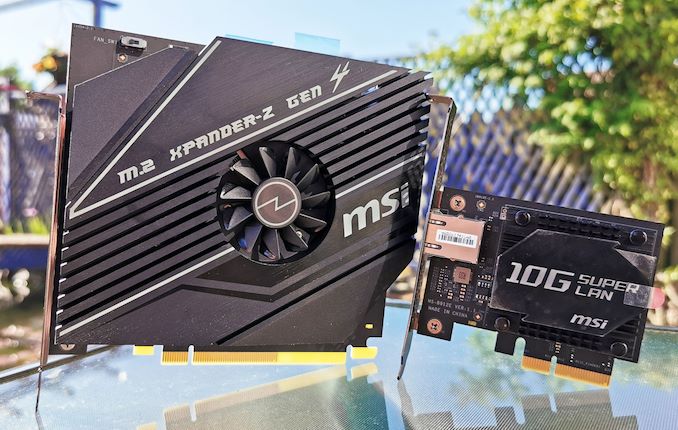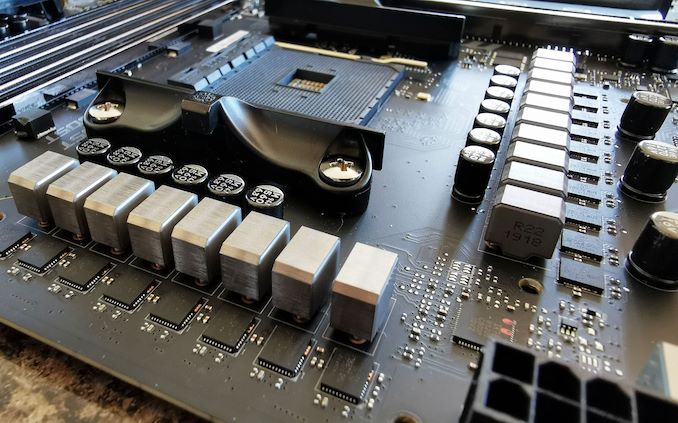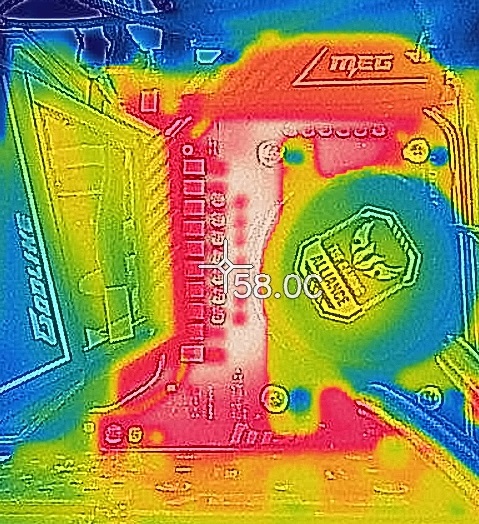The MSI MEG X570 Godlike Motherboard Review: Thor's Flagship
by Gavin Bonshor on August 28, 2019 12:00 PM EST- Posted in
- Motherboards
- AMD
- MSI
- 10G Ethernet
- Ryzen
- PCIe 4.0
- Ryzen 3000
- X570
- X570 Godlike
- MEG
MSI MEG X570 Godlike Conclusion
The MSI MEG X570 Godlike is an E-ATX motherboard which sits at the top of MSI's X570 product stack. It has a current price tag of $700 which puts it as one of the most expensive X570 models so far, and on paper it is one of the most feature-packed of all the X570 models. Other models that compete with this in terms of price point are the ASUS ROG Crosshair VIII Formula ($700), and the GIGABYTE X570 Aorus Xtreme ($700).
On offer is four full-length PCIe 4.0 slots which operate at x16, x8/x0/x8, and x8/x4/x4, while the bottom slot is locked to PCIe 4.0 x4. The MSI MEG X570 Godlike is the only X570 model with four full-length slots and as a consequence, has no PCIe 4.0 x1 slots. Its storage capabilities are also impressive with three PCIe 4.0 x4 M.2 slots on the board, with two additional PCIe 4.0 x4 drives due to the Xpander-Z Gen4 add-on card in the accessories bundle. On top of this, there are six SATA ports with support for RAID 0, 1, and 10 arrays.
Not only is the rear panel heavily packed with connections including three USB 3.1 G2 Type-A, one USB 3.1 G2 Type-C, and two USB 3.0 G1 Type-A ports, but the accessories bundle is also comprehensive with an Aquantia AQC107 10 G Super LAN card included; the other notable inclusion is six red and black braided SATA cables. Also included on the rear panel is a Flash BIOS and clear CMOS button which are very handy to have. A trio of Killer Networking powered ports including two Ethernet ports powered by an E3000 2.5 G and E2600 Gigabit NIC, but there is also an AX1650 Wi-Fi 6 802.11ax wireless interface which provides users with BT 5.0 connectivity too. Onboard audio is also boosted by the inclusion of an ESS 9018 Sabre DAC driven 6.3 mm headphone output, with a Realtek ALC1220 codec each for the front panel audio connector, and the five 3.5 mm jacks and S/PDIF optical output.
A reoccurring theme throughout the analysis of the MSI MEG X570 Godlike is the quality of the componentry, and its 16-phase power delivery as impressive as any board MSI has released over the last five years. The power delivery is using an International Rectifier IR35201 running at 7+1, with fourteen TDA21472 70 A power stages doubled up with seven IR3599 doublers. On the SoC section, there are four TDA21472 70 A power stages which are interestingly operating from a single IR3599 doubler running in quad mode; not exactly why MSI is using four power stages for the SOC when just two would have been suitable. The MSI X570 Godlike also boasts an impressive number of 4-pin fan headers with a total of nine splits into one for a CPU fan, one for a water pump, and seven for chassis fans.
On the performance front, the MSI MEG X570 Godlike performed consistently well throughout our CPU and gaming test suites. Power consumption was interesting in our testing with consistently higher than normal power draw in both idle and long idle power states, but matched other boards at peak load. This high idle power is likely due to the sheer number of controllers onboard.At full load, it performed on par with the MSI MEG X570 Ace which either shows the inefficiency of MSI's models at full-load; for reference, the ASUS Pro WS X570-Ace was a good 8 Watts better off at full load.

The MSI MEG X570 Godlike has an impressive accessories bundle
The overclocking performance was fruitful when done manually, with the 14-phase CPU power delivery and firmware doing its job well. MSI's Game Boost overclocking profiles on the other hand in our testing proved woefully inept with very high CPU VCore which in turn, put immense pressure on our 240 mm AIO CPU cooler on the testbed. MSI has reached out to us and stated that this issue will be addressed in the next firmware update. On a more positive note in our new power delivery thermal testing, the MSI MEG X570 Godlike performed very well with our overclocked Ryzen 7 3700X. The large power delivery heatsink is connected to the actively cooled X570 chipset heatsink via an aluminium heat pipe which seems to work very well with a maximum load temperature on the power delivery of 59°C from the integrated sensor, while our external probe on the rear recorded a maximum temperature of 61°C.
Overall the MSI MEG X570 Godlike is highly impressive and is the kind of flagship to get excited about. A lot of the features are overkill and add considerable expense such as the customizable OLED panel, the bolstered onboard audio and four full-length PCIe 4.0 slots. The majority of users aren't going to come close to using all of the Godlike's traits, which does bring questions about who exactly is buying a flagship motherboard at this price. Nonetheless, it is clear that MSI's Godlike makes a bold statement that MSI is in business when it comes to its X570 product design.
AnandTech Ryzen 3000 CPU and X570 Motherboard Coverage
- The AMD X570 Motherboard Overview: Over 35+ Motherboards Analyzed
- The MSI MEG X570 Ace Motherboard Review: Ace in the Hole at $369
- The AMD 3rd Gen Ryzen Deep Dive Review: 3700X and 3900X Raising The Bar
- AMD 16-Core Ryzen 9 3950X: Up to 4.7 GHz, 105W, Coming September
- AMD Zen 2 Microarchitecture Analysis: Ryzen 3000 and EPYC Rome
- AMD Ryzen 3000 Post-Review BIOS Update Recap: Larger ST Gains, Some Gains, Some Losses













116 Comments
View All Comments
inighthawki - Wednesday, August 28, 2019 - link
Depends what you're doing. The 9900K is already, at stock, anywhere from 5-10% better single core perf than AMD, and also overclocks much higher. So if you're willing to accept the additional power draw and thermal output and your goal is raw single core performance, then absolutely.If you're working in highly multithreaded scenarios then the new 3900 and 3950 chips are clearly a much superior choice.
Most people who are willing to spend this much money and OC their parts are also generally not too concerned with future proofing their systems. If you can afford (and are willing to spend) $700 on a motherboard, it stands to reason that money is not much of a concern and they probably don't care about having to buy a new motherboard for a new socket in a couple years.
StevoLincolnite - Wednesday, August 28, 2019 - link
The 9900K is only an 8-core CPU though........ AMD can trounce it with it's higher core-count parts in multi-threaded scenarios.yetanotherhuman - Thursday, August 29, 2019 - link
He does say that, and you know he hasn't edited his post, because it's not possible :DQasar - Thursday, August 29, 2019 - link
but why buy a 9900k when you can get the 3900X for the same price, use less power over all, pretty much the same IPC, and get 4 more cores on top of that ?? who cares if the 9900K can hit 5gz?? clock speed isnt everything, the Athlon 64 proved that way back when vs the P4. besides.. what if ryzen 3000 series did hit the same clocks as intel does, that would make intel's cpus look even worseinighthawki - Thursday, August 29, 2019 - link
Because the 9900K still edges out the 3900 (and presumably the 3950) in single threaded performance. Some people care about that more than having more cores.AshlayW - Thursday, August 29, 2019 - link
wow 5-10%, now tell me where that actually matters over the disadvantages of owning the 9900K vs Ryzen 3000.Oliseo - Thursday, August 29, 2019 - link
"wow 5-10%, now tell me where that actually matters over the disadvantages of owning the 9900K vs Ryzen 3000. "Compiling software for one. By it's very nature it's single threaded.
Likewise DAWs also prefer high frequency high IPC cores rather than multiple lower specced lower frequencey cores.
When you route your channels through an effects bus, that effects bus is allocated a core. It CANNOT be spread over multiple threads.
Asking silly questions like that only demonstrate your own ignorance, where you highlight you don't actually know what it is you're talking about.
It's okay though, we were all young once. I'd recommend in future putting aside your brand loyality though. It's not worth your effort, they aren't loyal to you in any shape or form.
peevee - Friday, August 30, 2019 - link
"Compiling software for one. By it's very nature it's single threaded."Seriously? You obviously missed an option or two.
29a - Friday, August 30, 2019 - link
I'm not disagreeing with you but those last two paragraphs were unnecessary. You'll catch more flies with honey than vinegar.Bus3rr0r - Friday, August 30, 2019 - link
Maybe if you are writing single module programs in your mom's basement a singel core is fine.Most devleopment projects of even relatively small projects have hundreds with larger projects running into thousands of modules. It is not only common practise to compile modules in parallel butit woudl be ridiculous not to.
The reality is there are very few applications that cannot take advantage of multi-core.
You critise others for their ignorance while demonstrating your ignorance, remarkable.